

PMSP's are documents that set future pest management priorities for a commodity and demonstrate stakeholder input in the process. Ideally, a PMSP outlines the current state of a commodity at the state, region, or national level. It presents a prioritized list of needs for research, regulatory activity, and extension education activities. The document takes a crop phenology and pest-by-pest approach to identifying both chemical and non-chemical options for pest control.
This information is used by the United States Department of Agriculture (USDA) and the Environmental Protection Agency (EPA) to understand pest management needs for commodities and to get input for the pesticide re- registration process under the Food Quality and Protection Act (FQPA). To make good regulatory decisions regarding pesticide registration issues and decisions on research/education funding, it is important for these organizations to get producer input.
The Kentucky Pest Management Center (KPMC) is sponsoring a soybean PMSP workshop in Bowling Green, Kentucky on August 4th & 5th. We are seeking producer input to this process. We invite individuals receiving Kentucky Pest News and who are involved with soybean production to list some of their pest management areas of concern, but a clear statement of problems or concerns would be most helpful. You are encouraged to provide as much or as little content as you feel necessary. Those interested in providing input should go to our website (http://www.uky.edu/Agriculture/KPMC/KPMC.htm) and fill out the pdf worksheet that has been posted.
WORKSHEET DIRECTIONS: Go to: http://www.uky.edu/Agriculture/KPMC/newsupdate.htm
If you have questions, please contact Lowell Sandell (lsandell@uky.edu or (859) 257-6693) or Dr. Doug Johnson (doug.johnson@uky.edu or (270) 365-7541 ext 214).

 Please alert us if blue mold is active in your county and we do not have your county listed in this report or on our status maps.
Please alert us if blue mold is active in your county and we do not have your county listed in this report or on our status maps.
The entire burley and dark tobacco production areas of the Ohio River Valley remain under a Blue Mold Advisory.
The blue mold situation in eastern and central Kentucky has changed significantly during the past week and continues to change rapidly as a result of highly favorable weather events and newly established centers of inoculum production. Recall from the last report that blue mold has been introduced into the area on transplants from east Tennessee. This is particularly significant, because the introductions occurred a month ago, and secondary spread has probably been occurring from those farms for several weeks, as well as the movement that has been occurring from the known centers of inoculum established in the southern Appalachians and middle Tennessee-western Kentucky. Conditions during the past 48 hours have been highly conducive for rapid development and spread in much of Kentucky.
In the last few days, new centers of strong blue mold activity producing new spores have been found near Hodgenville (Larue County), Richmond (Madison County), Lancaster (Garrard County), London-Somerset (Pulaski County), Barbourville (Knox County). Most of these reports involve large hot spot in fields of tobacco nearing topping stage. Some involve crops set with transplants from east Tennessee - but not all. One such introduction is in Madison County, Kentucky where 14 acres of tobacco with widespread blue mold activity is developing. It started in transplants obtained in mid-June from near Limestone, Tennessee. Many of these plants had systemic infections of the lower stem and root system, but most of the activity was associated with foliar lesions. The grower had held the Tennessee transplants in a local greenhouse with the remainder of his plants, where they had also become infected. He said the plants had arrived in a very yellowed state and grew slowly, so it was difficult to see yellow blue mold lesions on yellow leaves. No blue mold controls had been put into place until the grower found active disease in the field last week. I visited the farm and could easily count four to five generations of lesions in the field, plus probably one or two more had occurred in the greenhouse. From this grower we learned that other farmers in central Kentucky had also received transplants at about this same time from east Tennessee. So how many other sites like this are developing? Realize that we do not know where active blue mold is present in Kentucky, because we do not know where all the infected transplants were set. If the crop was set with plants from east Tennessee after about May 25, assume it has blue mold until proven otherwise. We need to get those communities using east Tennessee plants on our status maps (ASAP), to help growers appreciate their risk. Anyone with information about where Tennessee plants were used is ask to report it to their local county agent immediately, and agents are requested to promptly alert the Kentucky Blue Mold Warning System if they have such plants in the county. Without this information, the warning system is blind and the value of our information is greatly reduced!
The threat now is that there are some large fields producing heavy spore loads into the air, rather than a few lesions in shady areas of the field with a few lesions releasing spores. Therefore, I have expanded the watch area in the eastern and central two-thirds of Kentucky to include all counties in the Mammoth Cave, Lincoln Trail, Licking River, Bluegrass, Fort Harrod, Lake Cumberland, Quicksand, and Wilderness Trail areas. Do not under estimate this change in blue mold potential for the commonwealth! The inoculum potential has increased sharply within the last three days. Furthermore, appreciate that the host plant has become highly susceptible to blue mold during the past 10 days as recent rains and warm soils have allowed much of the crop to grow rapidly. For example, a Larue County farmer reported his crop went from just above knee height on July 10 to topping stage on July 22. All that new tissue is highly susceptible, plus it's shading of the lower leaves increases their susceptibility, too. In addition, the watch-areas have a large percentage of the crop that is very young tobacco; some of it with larger flowering crops nearby. Weather events forecast for the first half of this week will be highly conducive for sporulation and infection by the blue mold pathogen. With cool temperatures in the 60's and 70's, expect each lesion to cause more damage as lesions will be larger with a sharp increase in systemic activity associated with veins, mid-ribs, and buds/stems. In Kentucky, warnings are present for those with active blue mold which has been confirmed in the following Kentucky counties: Garrard, Knox, Larue, Madison, Estill, Jackson, Pulaski, Logan, Todd, Breathitt, and Perry. Blue mold also continues to build in the Appalachian region with activity in western North Carolina, east Tennessee, and western Virginia. Some of the reports involved multiple fields with strong inoculum production.
In counties under a watch reduce the plant's susceptibility to blue mold by using Actigard 50W if the plants are large enough, otherwise, start sprays with Acrobat MZ if located with 25 miles of active blue mold. In counties under a warning, at least one spray of Acrobat MZ should be made to reduce inoculum even if Actigard will be used. In fields of young tobacco (prior to topping) with active blue mold , use aggressive spray programs with Acrobat MZ to get the disease under control, plus activate the plant's immune system with Actigard. In fields at the topping stage, Actigard may help improve resistance, but topping and including MH-type materials in the sucker control program are even more important.
Application guidelines for the fungicides labeled for blue
mold control in the field in Kentucky can be found in
Kentucky Pest News, April 28, 2003 issue number 983 at web address -
http://www.uky.edu/Agriculture/kpn/kpn_03/pi030428.htm
For the latest blue mold status and other tobacco disease information, check the KY Blue Mold Warning System online.
![]() http://www.uky.edu/Agriculture/kpn/kyblue/kyblue.htm
http://www.uky.edu/Agriculture/kpn/kyblue/kyblue.htm
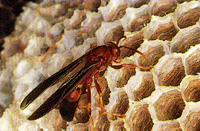 Paper wasps, hornets and yellowjackets, and bumble bees
often nest in and around barns but also can occur in some
unexpected places. You may even find a nest was
discovered in the hollow tongue of a wagon. In addition to
painful stings, people working high up on rails in a barn
can be injured as they try to escape these angry insects. As
if this were not enough, some people can have a severe
allergic reaction to the venom of these insects. Wasps,
hornets and yellowjackets are more dangerous and
unpredictable than honey bees and should be treated with
respect; nests should be eliminated with great care and in a
specific manner.
Paper wasps, hornets and yellowjackets, and bumble bees
often nest in and around barns but also can occur in some
unexpected places. You may even find a nest was
discovered in the hollow tongue of a wagon. In addition to
painful stings, people working high up on rails in a barn
can be injured as they try to escape these angry insects. As
if this were not enough, some people can have a severe
allergic reaction to the venom of these insects. Wasps,
hornets and yellowjackets are more dangerous and
unpredictable than honey bees and should be treated with
respect; nests should be eliminated with great care and in a
specific manner.
Paper wasps, hornets and yellowjackets construct nests of a paper-like material which is a mixture of finely chewed wood fragments and salivary secretions of the wasps. Paper wasps typically build their umbrella-shaped nests under eaves and ledges. These wasps are not as aggressive as yellowjackets or hornets, and can be eliminated rather easily with a wasp and hornet spray sold at most grocery and hardware stores. These formulations have an added advantage in that they often spray as far as 20 feet.
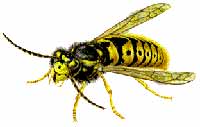 Treatment of wasps, hornets, and yellowjackets is best
performed at night; paper wasps can be eliminated during
the daytime provided you do not stand directly below the
nest during treatment. Most wasp and hornet sprays cause
insects to drop instantly when contacted by the insecticide.
Standing directly below a nest increases one's risk of being
stung. Following treatment, wait a day to ensure that the
colony is destroyed, then scrape or knock down the nest.
This will prevent secondary problems from carpet beetles,
ants and other scavenging insects.
Treatment of wasps, hornets, and yellowjackets is best
performed at night; paper wasps can be eliminated during
the daytime provided you do not stand directly below the
nest during treatment. Most wasp and hornet sprays cause
insects to drop instantly when contacted by the insecticide.
Standing directly below a nest increases one's risk of being
stung. Following treatment, wait a day to ensure that the
colony is destroyed, then scrape or knock down the nest.
This will prevent secondary problems from carpet beetles,
ants and other scavenging insects.
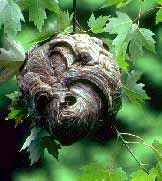 Hornets are far more difficult and dangerous to control
than paper wasps. The nests resemble a large, inverted
tear-drop shaped ball which typically is attached to a
tree, bush or side of a building. Hornet nests may contain
thousands of wasps which are extremely aggressive
when disturbed. Treatment can be accomplished by
applying a wasp freeze-type, aerosol insecticide or dust
formulation (Sevin) directly into the nest opening.
Hornets are far more difficult and dangerous to control
than paper wasps. The nests resemble a large, inverted
tear-drop shaped ball which typically is attached to a
tree, bush or side of a building. Hornet nests may contain
thousands of wasps which are extremely aggressive
when disturbed. Treatment can be accomplished by
applying a wasp freeze-type, aerosol insecticide or dust
formulation (Sevin) directly into the nest opening.
Hornet nests have a single opening, usually toward the bottom, where the wasps enter and exit. It is essential that the paper envelope of the nest not be broken open during treatment or the irritated wasps will scatter in all directions, causing even greater problems. Following treatment, wait at least a day before removing the nest to ensure that all of the wasps are killed. If hornets continue to be observed, the application may need to be repeated.
 Bumble bees can nest in small piles of hay, paper, or
other similar materials, usually at ground level. Look for
activity around the barn and deal with it before the rush
of housing begins.
Bumble bees can nest in small piles of hay, paper, or
other similar materials, usually at ground level. Look for
activity around the barn and deal with it before the rush
of housing begins.
See "Insect Management Recommendations" for more insecticide recommendations on tobacco and other crops and livestock.

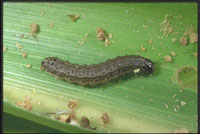 There have been a few reports of fall armyworm in late
planted corn fields. In particular, growers need to pay
close attention to corn while it is still in the whorl stage.
Most of the corn planted in mid May and before has
already tasseled and is less attractive to fall armyworm.
When monitoring fields, look for ragged leaves emerging
from the whorl. Often several adjacent plants may be
damaged as this insect lays its eggs in small groups.
When determining whether or not to treat a particular
field, try to target sprays at smaller larvae as they are
much easier to control.
There have been a few reports of fall armyworm in late
planted corn fields. In particular, growers need to pay
close attention to corn while it is still in the whorl stage.
Most of the corn planted in mid May and before has
already tasseled and is less attractive to fall armyworm.
When monitoring fields, look for ragged leaves emerging
from the whorl. Often several adjacent plants may be
damaged as this insect lays its eggs in small groups.
When determining whether or not to treat a particular
field, try to target sprays at smaller larvae as they are
much easier to control.
For more information about corn pests, visit "Insect Management Recommendations".
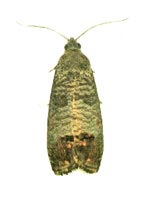 Late season codling moth generations are often
overlooked by growers, but these are the larvae that can
remain in the apples at harvest. In Kentucky, we have
between three and four codling moth generations per
year depending on the year. The first two generations are
managed well by growers, but occasionally, as growers
become involved with peach and early-season apple
harvest, less attention is given to codling moth control.
But codling moth can attack through September in
Kentucky. Grower should be reminded to continue to use
and maintain codling moth pheromone traps through the
end of September, and to spray accordingly.
Late season codling moth generations are often
overlooked by growers, but these are the larvae that can
remain in the apples at harvest. In Kentucky, we have
between three and four codling moth generations per
year depending on the year. The first two generations are
managed well by growers, but occasionally, as growers
become involved with peach and early-season apple
harvest, less attention is given to codling moth control.
But codling moth can attack through September in
Kentucky. Grower should be reminded to continue to use
and maintain codling moth pheromone traps through the
end of September, and to spray accordingly.
 An unseen problem of grapes in Kentucky is that of the
grape root borer. While damage and vine loss by this insect
is not common in new vineyards, it is more common in
older vinegards. The larvae of the grape root borer feed for
two years below ground, emerge and lay eggs on grape
foliage and weeds around the base of grape vines. The
adults are paper wasp mimics and, unlike most other
moths, these are day fliers that are commonly seen on
grape foliage during midday. Grape root borer adult moths
should become active in the next weeks. The presence of
pupal cases around the bases of 5% vines is the threshold
for treatment of the vines next year.
An unseen problem of grapes in Kentucky is that of the
grape root borer. While damage and vine loss by this insect
is not common in new vineyards, it is more common in
older vinegards. The larvae of the grape root borer feed for
two years below ground, emerge and lay eggs on grape
foliage and weeds around the base of grape vines. The
adults are paper wasp mimics and, unlike most other
moths, these are day fliers that are commonly seen on
grape foliage during midday. Grape root borer adult moths
should become active in the next weeks. The presence of
pupal cases around the bases of 5% vines is the threshold
for treatment of the vines next year.
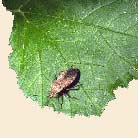 There have been several reports of high squash bug
numbers in squash, pumpkins and other cucurbit
vegetables. While squash bug can damage plants and fruits
by removing large amounts of sap with its sucking
mouthparts, it is also a vector of the agent that causes
Yellow Vine Decline. Control of this disease depends on
control of squash bugs. For this reason, we now
recommend preventive controls for squash bug in
cucurbits crops that are highly susceptible to yellow vine
decline.
There have been several reports of high squash bug
numbers in squash, pumpkins and other cucurbit
vegetables. While squash bug can damage plants and fruits
by removing large amounts of sap with its sucking
mouthparts, it is also a vector of the agent that causes
Yellow Vine Decline. Control of this disease depends on
control of squash bugs. For this reason, we now
recommend preventive controls for squash bug in
cucurbits crops that are highly susceptible to yellow vine
decline.
Some of the growers noted that they had treated these fields with Admire or Platinum and were still finding squash bugs at moderate to high numbers when they had begun picking. Keep in mind that these insecticides are primarily targeting cucumber beetles, and they provide 3 to 5 weeks of control depending on the rate of application. However, squash bug is not listed on the Admire or Platinum label. But research at the UK South Farm has shown us that these insecticides will also provide some squash bug control. We have observed that the duration of control is not as long as it is with the cucumber beetles.
 Blister beetles have softer bodies than most beetles but they
pack an irritating punch that more than makes up for
structural limitations. Blister beetle blood is laced with
cantharidin, a blistering agent that can raise welts if the
beetles are smashed on the skin. We have several species
in Kentucky including black, margined, and striped
blister beetles. Several species feed on crops but the
margined and striped blister beetles can be found feeding
on eggplant, potato, tomato. Blister beetles often
accumulate in groups on plants, feeding on flowers or
foliage. Extensive defoliation can occur but it is usually
limited to hot spots in the garden.
Blister beetles have softer bodies than most beetles but they
pack an irritating punch that more than makes up for
structural limitations. Blister beetle blood is laced with
cantharidin, a blistering agent that can raise welts if the
beetles are smashed on the skin. We have several species
in Kentucky including black, margined, and striped
blister beetles. Several species feed on crops but the
margined and striped blister beetles can be found feeding
on eggplant, potato, tomato. Blister beetles often
accumulate in groups on plants, feeding on flowers or
foliage. Extensive defoliation can occur but it is usually
limited to hot spots in the garden.

I found only three published research reports on control of anthracnose with Medallion. Undoubtedly, more research is currently underway. Nevertheless, three studies is enough to form some impressions. In one study where basal rot anthracnose was reported, complete control was provided by Medallion alone. In a second site with basal rot anthracnose, partial control was provided by Medallion, but complete control was achieved when Medallion was mixed with Daconil Ultrex as described above. In a third study where only foliar anthracnose was reported, health of Poa annua was not improved by either Medallion alone or in combination with Daconil Ultrex at 1.8 oz/1000 sq ft.
Given the general difficulty of controlling basal rot
anthracnose on some golf courses, and the emergence of
strains of Colletotrichum graminicola at many sites in the
U.S., including Kentucky, I can imagine this product will
have some utility as part of a control program. Clearly,
more research is needed to develop a clear picture of how
well the product will work, but it appears to have some
potential for controlling the basal rot phase, the most
damaging phase of the disease. Curative control has not
been tested; these studies are with preventive control only.
However, recovery from basal rot infections is very
difficult during summer, so I doubt that any product will
be a magic bullet for that situation.
Many woody landscape plants are showing evidence of leaf spot and leaf blight diseases this summer. With frequent rains, weather conditions this spring were ideal for infection by many pathogens. Warm, humid weather with occasional thundershowers this summer have further encouraged many foliar diseases. County Extension Agents and landscape managers are often faced with identifying or managing foliar diseases in landscape plantings. The following is a list of common landscape plant foliar diseases being seen now in the field and in the U.K. Plant Disease Diagnostic Laboratory.
Ash - anthracnose. Azalea - leaf and flower gall. Birch - Septoria leaf spot. Cherry - Coccomyces leaf spot. Crabapple - cedar-apple rust; fire blight; frogeye leaf spot; scab. Dogwood - anthracnose; powdery mildew; Septoria leaf spot. Hawthorn - cedar-hawthorn rust; cedar-quince rust; Entomosporium leaf spot. Holly - bacterial blight. Ivy - bacterial spot, Colletotrichum leaf spot. Juniper - cedar-apple rust; cedar-hawthorn rust; cedar-quince rust; Phomopsis twig blight. Magnolia - bacterial leaf spot. Maple - anthracnose; Cristulariella leaf spot; Phyllosticta leaf spot. Mock-orange - bacterial leaf spot. Mulberry - Cylindrosporium leaf spot. Oak - Actinopelte leaf spot; anthracnose; bacterial leaf scorch; oak leaf blister. Pear - fire blight; Phyllosticta leaf spot. Pine - Dothistroma needle blight; pine needle rust; Sphaeropsis tip blight. Photinia - Entomosporium leaf spot. Planetree - powdery mildew; Septoria leaf spot. Prunus species - bacterial leaf spot. Redbud - anthracnose. Rose - black spot; rosette. Serviceberry - cedar-quince rust. Spruce - Rhizosphaera needle cast. Sycamore - anthracnose; powdery mildew. Witch hazel - Phyllosticta leaf blotch. Yellowwood - leaf blight.
Most of the foliar diseases of landscape plants listed here are not fatal diseases. Some, like crabapple scab and dogwood powdery mildew, cause plants to be unattractive and will reduce flowering the next year.
Managing woody plant foliar diseases.
Application of a cattle grub treatment is one of the Kentucky CPH requirements. Cattle grub damage to muscle and hide requires extra trimming of carcasses and decreases the value of hides. Grubby carcasses are routinely docked by packers.
Cattle grub control is a part of producing quality steers for the feedlot. While the damage (cysts or swellings long the back line) will not show up for several months, control measures must be applied to Kentucky cattle between now and October 31 to kill the pests without harming the animal.
HOST REACTION TO CATTLE GRUBS
Depending upon the species, cattle grub larvae move
either to the esophagus (common cattle grub) or spinal
column (northern cattle grub)during their migration to
the back. The grub larvae are in these sensitive areas
during November and December. If large grubs are killed
there, the surrounding tissue can become severely
inflamed and additional symptoms can develop.
In animals infested with the common cattle grub, the esophagus can swell shut, and produce difficulty swallowing, drooling, or bloat. Northern cattle grubs killed in the region of the spine can put pressure on the spinal column. This results in stiffness in the hind quarters, loss of balance, or inability to lift the hind feet.
Be careful when treating for grubs. Use accurate weight estimates to determine the proper dose. Undertreating may not provide satisfactory control. At best, overtreatment will waste money; at worst, it may cause the animal to become sick.
There are a variety of formulations of cattle grub insecticides. Pour-on or Spot-On products are convenient if good handling facilities are available. High pressure sprays are an alternative when chutes or working pens are not an option. Animals must be wet to the skin when high pressure sprays are used. Products for internal parasite control, such as Cydectin, Dectomax, or Ivomec, also will control cattle grubs. When these products are applied, there is no need to treat with an insecticide, too.
For more information livestock pests, visit "Insect Management Recommendations".

Samples in the Diagnostic Laboratory this past week included leaf hopper injury and Lepto leaf spot on alfalfa; black shank, soreshin, blue mold, nitrogen deficiency, alfalfa mosaic virus, tobacco streak virus, tomato spotted wilt virus, and manganese toxicity on tobacco.
On fruits and vegetables, we have seen black rot on grape; brown rot on apricot and peach; Rhizoctonia root and stem rot on bean; poor pollination on cantaloupe; bacterial stalk rot on sweet corn; blossom end rot on pepper; and Septoria leaf spot, early blight, bacterial canker, and blossom end rot on tomato.
On ornamentals, we have seen Septoria leaf spot and powdery mildew on dogwood; leaf/flower gall on azalea; bacterial spot on ivy; leaf hopper injury on maple; magnolia scale on magnolia; Cylindrosporium leaf spot on weeping mulberry; Entomosporium leaf spot on photinia; and leaf scorch and dieback on many woody ornamentals from a variety of environmental stresses including chronic drought stress (from the past several summers) and transplant shock.

UKREC-Princeton, KY, July 11-18, 2003 | Black cutworm
| 1
| True armyworm
| 11
| Fall armyworm
| 0
| European corn borer
| 6
| Southwestern corn borer
| 20
| Corn earworm
| 28
| | |
NOTE: Trade names are used to simplify the information presented in this newsletter. No endorsement by the Cooperative Extension Service is intended, nor is criticism implied of similar products that are not named.
Lee Townsend
Extension Entomologist